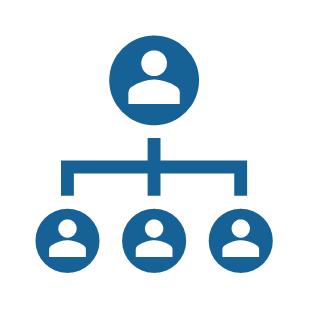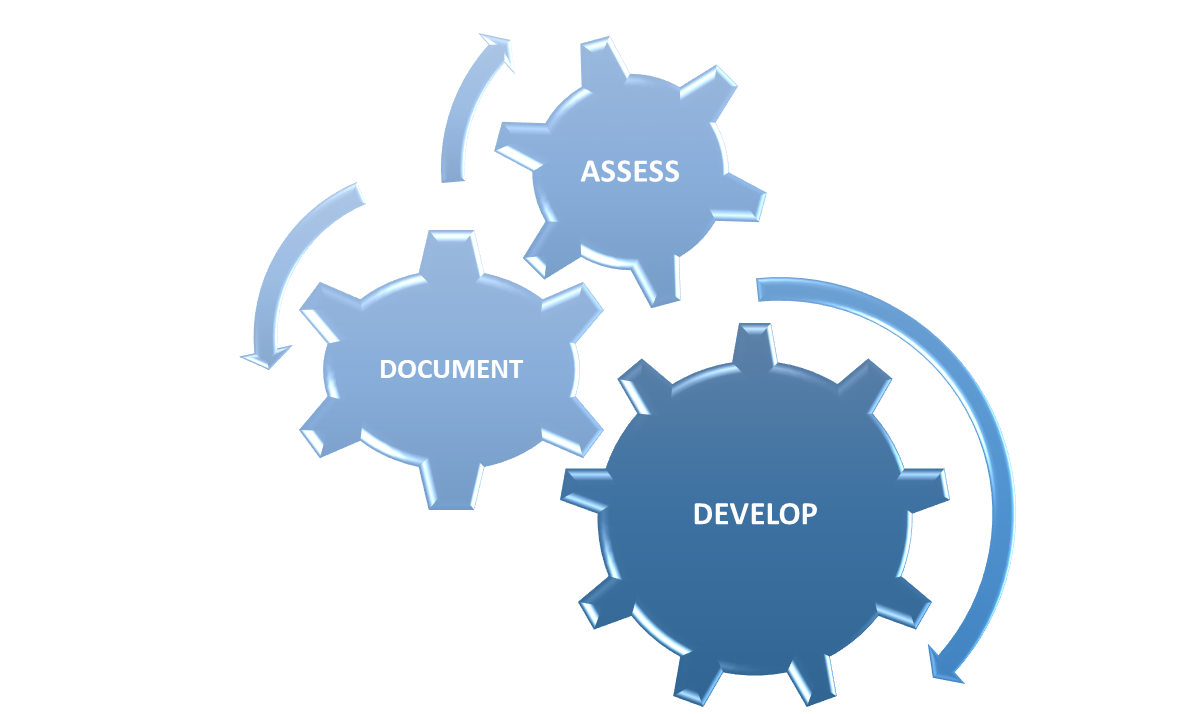Staffing and Succession Planning
 Succession planning is a strategy for developing future leaders. It involves "a conscious decision by an organization to foster and promote the continual development of employees and ensure that key positions maintain some measure of stability, thus enabling an organization to achieve business objectives1." Simply put, succession planning is recognizing that change is inevitable, and planning for it in a way that prevents or minimizes negative impacts.
Succession planning is a strategy for developing future leaders. It involves "a conscious decision by an organization to foster and promote the continual development of employees and ensure that key positions maintain some measure of stability, thus enabling an organization to achieve business objectives1." Simply put, succession planning is recognizing that change is inevitable, and planning for it in a way that prevents or minimizes negative impacts.
Why is succession planning important? What benefits does it provide?
Improves employee retention, morale, and performance
When you demonstrate to your employees that they are valued by investing in their growth and development, they're likely to stay longer in your organization. Succession planning creates more transparent pathways to career development and advancement within an organization. That transparency in turn encourages employees to take better ownership of their work and take an active role in their career progression.
Ensures stability
Can you think of one or more people in your financial aid office who have valuable, specialized, institutional knowledge that would interrupt your operations if they were to leave suddenly? Maybe you've experienced that kind of interruption already. Succession planning that includes cross-training, documentation, and leadership development makes it easier to fill in for and then replace those key roles in a way that preserves a sense of stability for staff and students throughout staffing transitions.
Facilitates knowledge transfer
Think about the last time a team member left their position in your office. If you were lucky, you probably had two or more weeks with them before they officially left. Were those two weeks enough time to teach someone else everything about their job duties? How effectively were they able to pass along their institutional knowledge during that time? When processes are well-documented and employees are cross-trained, you don't have to worry about starting from scratch or reinventing the wheel every time an employee leaves or moves to a new role. Good succession planning preserves the legacy of our achievements and experiences. This allows your team members to spend more time innovating and improving processes, rather than figuring out the basics of the job.
Promotes long-term success
Consistent investment in developing your staff helps build you a pool of talent that can eventually move into and even compete for key positions. Your team members aren't fixed assets — changes to your staff are inevitable. You can't always predict when someone critical will leave, but succession planning facilitates better continuity that is essential to your institution's continued success.
 Succession Planning How-to Guide
Succession Planning How-to Guide
Assess
- Take a look at your office and identify key positions. A key position is one that would have a significant and detrimental impact on your operations if the person occupying it were to leave suddenly. Every person on our team, of course, plays an important role in serving students, but there are likely one or more roles that would be a substantial challenge to replace quickly. These positions are a good place to start making succession plans. Here you'll want to ask questions like:
- What is the day-to-day impact of this position on our institution and department?
- If the person currently in this position left, how would that affect our operations?
- Take an inventory of the skills, competencies, knowledge, and experience in your office. Ask:
- What gaps exist?
- What are we in short supply of?
- What skills, competencies, knowledge, etc. are essential for our office to function?
- What are the actual requirements for each position?
- Evaluate the potential and possible career paths for your team members with particular focus on who would be a good fit or can be developed to move into key positions when they become open. Involve your team members in this step by finding out what their career goals and aspirations are. This is a good place to ask questions like:
- Who is likely to retire in the next five to 10 years?
- If you were to hire for each key position internally, which employees would be the strongest candidates? Would these candidates need training?
- Which employee could step into my position some day? What can I do, starting now, to help that person prepare for the transition?
Document
- Job descriptions are a great place to start. You probably have a job description for most, if not all, of your positions. But how often do you review and update them? Do they accurately reflect the technical skills required to be successful in the position? Has anything crept into the "other duties as assigned" item and become an essential part of the job? What soft skills help to ensure success in this role?
- Ensuring that job descriptions are accurate and up to date is an essential process. It can help with career planning and it gives both internal and external candidates better expectations for the position they're applying for.
- P&P&P — We're all familiar with the classic policies and procedures, or "P&P" manual, but let's elevate a third "P" to that level of importance: Processes. These 3 Ps might not belong in the same manual, but they should all be written down and stored in an easily accessible, central location.
- Policies are high-level rules or guidelines that give employees direction to ensure compliance;
- Processes are a set of interrelated activities that turn inputs into outputs; put simply: a process spells out what you do, but not how you do it. Picture a process map or flowchart.
- Procedures are detailed, step-by-step instructions — a "click here then here" type of guide.
- To add just one more documentation layer, it's also important to think about how we teach people these policies, processes, and procedures. P&P&P documentation is essential reference material, but you may also find it useful to create documentation specifically geared toward facilitating training.
Develop
- When it comes to development, it's important that we nurture internal talent.
- Promoting from within gives you the benefit of employees with strong existing relationships and institutional knowledge who can more seamlessly move into new roles.
- Your ability and willingness to develop your existing team members shows investment that improves retention and gives you better options for filling positions in the future.
- Be intentional about developing others and getting them involved and actively participating in their own development.
- Remember that not everyone aspires to move into a leadership role, so think about how you can develop leadership skills as well as skills and competencies required for higher level non-leadership roles.
- Don't be shy about including yourself in the internal talent that deserves to be nurtured! Be willing to advocate for and take advantage of the same level of support you offer to your team members.
- Mentoring can play an important role in development.
- Connect your high potential team members with mentors that can help them build relationships and make smart career choices. Consider mentors within and outside of your department.
- Training and cross-training
- Cross-train people to be able to serve as backups to key positions. This is an excellent way to develop team members and create contingency plans.
- This can allow you to do a trial run of your succession plan! Instead of waiting for a moment of crisis, prepare in advance and then ask a potential successor to take on responsibilities for someone while they're on vacation or focusing on other projects. Doing so can help you assess where that person is and what additional training and support they may need.
- Finally, Professional Development Plans
- Development is so much more effective when it's intentional and focused on producing desired outcomes.
Succession Planning Tips & Tricks
Start NOW
If you wait to document processes and identify successors until you know someone is leaving their position, you're already behind. Starting today will help you get prepared for whatever the future brings.
Work on it consistently
Succession planning isn't a project with a definite start and end date — it's an ongoing process that needs regular attention. Creating process documentation for everything your office does can be a daunting task. You can make it more manageable by creating a plan and working on it a little bit at a time.
Make it part of team culture
Set clear expectations for yourself and your team that make things like documentation and professional development an important part of your day-to-day work.
Be transparent
Be intentional and open about preparing team members for career advancement. You probably can't guarantee a promotion or new job, but you should empower your team members to take ownership of and actively engage in their growth and development. Work with your team members to identify the skills, competencies, and experience that they need to gain or improve on, then facilitate opportunities for them to do so.
Invest in yourself and your team
You should simultaneously be investing in your own development, preparing for your next career step, and investing in the development of your team members.
Reference
Resources
- Sample Job Descriptions
- Sample Interview Questions
- Benchmarking Salary & Staffing Data
- Retaining Talented Employees Presentation
- Onboarding Checklists, Templates, and Presentation
- On-Boarding Outline for Staff (.docx)
- On-Boarding Outline for Leaders (.docx)
- 30-Day Check-In Outline (.docx)
- 60-Day Check-In Outline (.docx)
- 90-Day Check-In Outline (.docx)
- Boot Camp/Onboarding Training Schedule Sample (.xlsx)
- RMASFAA Training Presentation for Onboarding New Financial Aid Officers (.pdf)
Return to Toolkit Home | Continue to Cultivating a Healthy Office Culture >>



